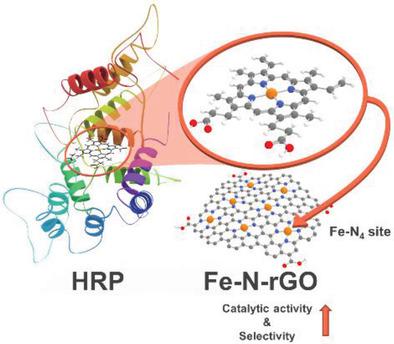当前位置:
X-MOL 学术
›
Adv. Funct. Mater.
›
论文详情
Our official English website, www.x-mol.net, welcomes your
feedback! (Note: you will need to create a separate account there.)
Heme Cofactor‐Resembling Fe–N Single Site Embedded Graphene as Nanozymes to Selectively Detect H2O2 with High Sensitivity
Advanced Functional Materials ( IF 18.5 ) Pub Date : 2019-11-11 , DOI: 10.1002/adfm.201905410 Min Su Kim 1 , Junsang Lee 2 , Hye Su Kim 3 , Ara Cho 1 , Kyu Hwan Shim 3 , Thao Nguyen Le 3 , Seong Soo A. An 3 , Jeong Woo Han 1 , Moon Il Kim 3 , Jinwoo Lee 2
Advanced Functional Materials ( IF 18.5 ) Pub Date : 2019-11-11 , DOI: 10.1002/adfm.201905410 Min Su Kim 1 , Junsang Lee 2 , Hye Su Kim 3 , Ara Cho 1 , Kyu Hwan Shim 3 , Thao Nguyen Le 3 , Seong Soo A. An 3 , Jeong Woo Han 1 , Moon Il Kim 3 , Jinwoo Lee 2
Affiliation

|
Over the past decade, the catalytic activity of nanozymes has been greatly enhanced, but their selectivity is still low and considered a critical issue to overcome. Herein, Fe–N4 single site embedded graphene (Fe–N‐rGO), which resembles the heme cofactor present in natural horseradish peroxidase, shows a marked enhancement in peroxidase‐like catalytic efficiency of up to ≈700‐fold higher than that of undoped rGO as well as excellent selectivity toward target H2O2 without any oxidizing activity. Importantly, when Fe or N is doped alone or when Fe is replaced with another transition metal in the Fe–N4 site, the activity is negligibly enhanced, showing that mimicking the essential cofactor structure of natural enzyme might be essential to design the catalytic features of nanozymes. Density functional theory results for the change in Gibbs free energy during the peroxide decomposition reaction explain the high catalytic activity of Fe–N‐rGO. Based on the high and selective peroxidase‐like activity of Fe–N‐rGO, trace amounts of H2O2 produced from the enzymatic reactions from acetylcholine and cancerous cells are successfully quantified with high sensitivity and selectivity. This work is expected to encourage studies on the rational design of nanozymes pursuing the active site structure of natural enzymes.
中文翻译:

血红素辅因子重组Fe–N单点嵌入石墨烯作为纳米酶,以高灵敏度选择性检测H2O2
在过去的十年中,纳米酶的催化活性已大大提高,但其选择性仍然很低,被认为是需要克服的关键问题。本文中,类似于天然辣根过氧化物酶中存在的血红素辅因子的Fe–N 4单点嵌入石墨烯(Fe–N–rGO),其过氧化物酶样催化效率显着增强,比普通辣根过氧化物酶高约700倍。未掺杂的rGO以及对目标H 2 O 2的优异选择性,而无任何氧化活性。重要的是,当单独掺杂Fe或N或当Fe–N 4中的Fe被另一种过渡金属替代时该位点的活性可忽略不计地增强,表明模仿天然酶的必需辅因子结构对于设计纳米酶的催化特性可能是必不可少的。在过氧化物分解反应过程中吉布斯自由能变化的密度泛函理论结果解释了Fe–N‐rGO的高催化活性。基于Fe–N‐rGO的高选择性过氧化物酶样活性,可以成功地以高灵敏度和高选择性对乙酰胆碱和癌细胞的酶促反应产生的痕量H 2 O 2进行定量。预期这项工作将鼓励对追求天然酶活性位点结构的纳米酶进行合理设计的研究。
更新日期:2020-01-04
中文翻译:

血红素辅因子重组Fe–N单点嵌入石墨烯作为纳米酶,以高灵敏度选择性检测H2O2
在过去的十年中,纳米酶的催化活性已大大提高,但其选择性仍然很低,被认为是需要克服的关键问题。本文中,类似于天然辣根过氧化物酶中存在的血红素辅因子的Fe–N 4单点嵌入石墨烯(Fe–N–rGO),其过氧化物酶样催化效率显着增强,比普通辣根过氧化物酶高约700倍。未掺杂的rGO以及对目标H 2 O 2的优异选择性,而无任何氧化活性。重要的是,当单独掺杂Fe或N或当Fe–N 4中的Fe被另一种过渡金属替代时该位点的活性可忽略不计地增强,表明模仿天然酶的必需辅因子结构对于设计纳米酶的催化特性可能是必不可少的。在过氧化物分解反应过程中吉布斯自由能变化的密度泛函理论结果解释了Fe–N‐rGO的高催化活性。基于Fe–N‐rGO的高选择性过氧化物酶样活性,可以成功地以高灵敏度和高选择性对乙酰胆碱和癌细胞的酶促反应产生的痕量H 2 O 2进行定量。预期这项工作将鼓励对追求天然酶活性位点结构的纳米酶进行合理设计的研究。































 京公网安备 11010802027423号
京公网安备 11010802027423号